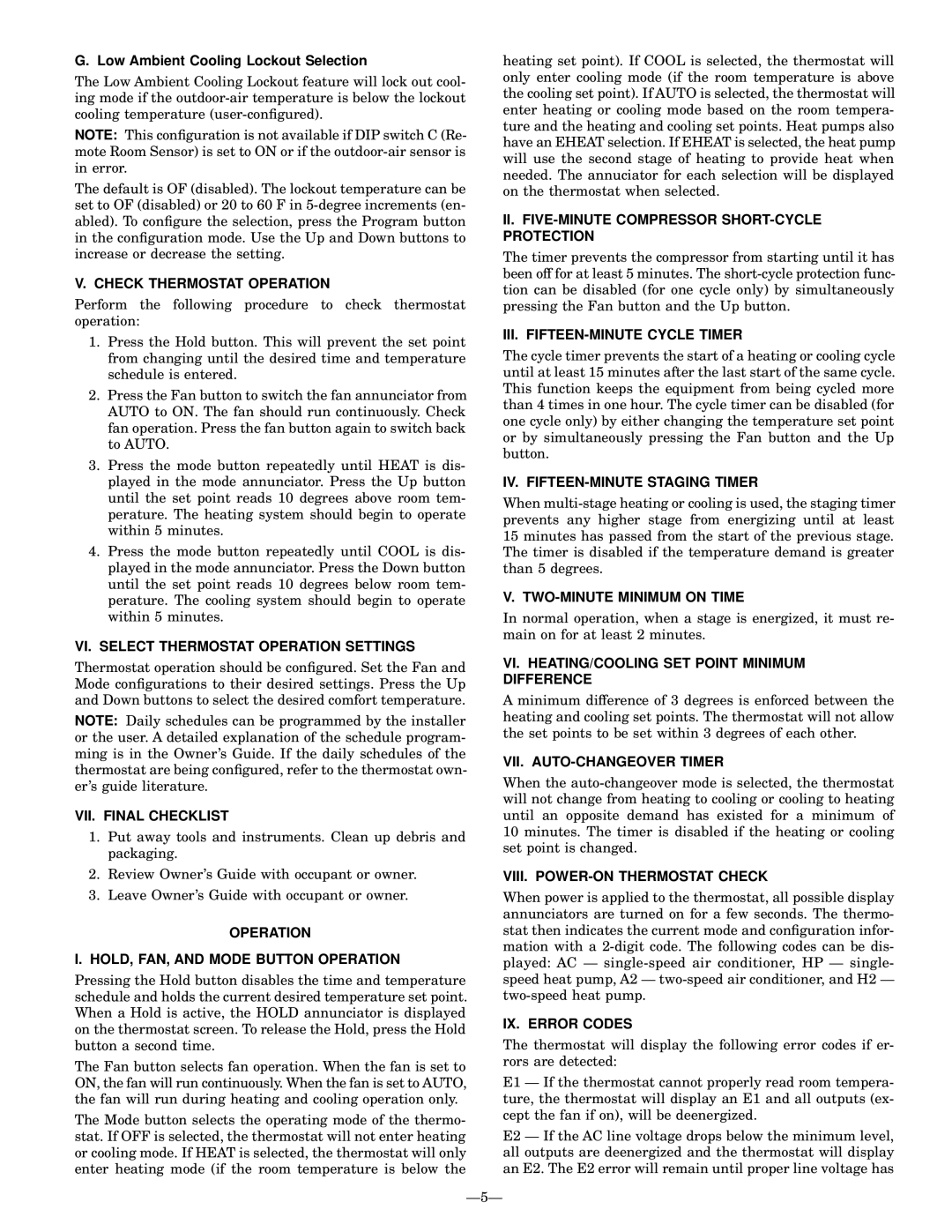G. Low Ambient Cooling Lockout Selection
The Low Ambient Cooling Lockout feature will lock out cool- ing mode if the
NOTE: This con®guration is not available if DIP switch C (Re- mote Room Sensor) is set to ON or if the
The default is OF (disabled). The lockout temperature can be set to OF (disabled) or 20 to 60 F in
V. CHECK THERMOSTAT OPERATION
Perform the following procedure to check thermostat operation:
1.Press the Hold button. This will prevent the set point from changing until the desired time and temperature schedule is entered.
2.Press the Fan button to switch the fan annunciator from AUTO to ON. The fan should run continuously. Check fan operation. Press the fan button again to switch back to AUTO.
3.Press the mode button repeatedly until HEAT is dis- played in the mode annunciator. Press the Up button until the set point reads 10 degrees above room tem- perature. The heating system should begin to operate within 5 minutes.
4.Press the mode button repeatedly until COOL is dis- played in the mode annunciator. Press the Down button until the set point reads 10 degrees below room tem- perature. The cooling system should begin to operate within 5 minutes.
VI. SELECT THERMOSTAT OPERATION SETTINGS
heating set point). If COOL is selected, the thermostat will only enter cooling mode (if the room temperature is above the cooling set point). If AUTO is selected, the thermostat will enter heating or cooling mode based on the room tempera- ture and the heating and cooling set points. Heat pumps also have an EHEAT selection. If EHEAT is selected, the heat pump will use the second stage of heating to provide heat when needed. The annuciator for each selection will be displayed on the thermostat when selected.
II.FIVE-MINUTE COMPRESSOR SHORT-CYCLE PROTECTION
The timer prevents the compressor from starting until it has been off for at least 5 minutes. The
III. FIFTEEN-MINUTE CYCLE TIMER
The cycle timer prevents the start of a heating or cooling cycle until at least 15 minutes after the last start of the same cycle. This function keeps the equipment from being cycled more than 4 times in one hour. The cycle timer can be disabled (for one cycle only) by either changing the temperature set point or by simultaneously pressing the Fan button and the Up button.
IV. FIFTEEN-MINUTE STAGING TIMER
When
V. TWO-MINUTE MINIMUM ON TIME
In normal operation, when a stage is energized, it must re- main on for at least 2 minutes.
Thermostat operation should be con®gured. Set the Fan and Mode con®gurations to their desired settings. Press the Up and Down buttons to select the desired comfort temperature.
NOTE: Daily schedules can be programmed by the installer or the user. A detailed explanation of the schedule program- ming is in the Owner's Guide. If the daily schedules of the thermostat are being con®gured, refer to the thermostat own- er's guide literature.
VII. FINAL CHECKLIST
1.Put away tools and instruments. Clean up debris and packaging.
2.Review Owner's Guide with occupant or owner.
3.Leave Owner's Guide with occupant or owner.
OPERATION
I. HOLD, FAN, AND MODE BUTTON OPERATION
Pressing the Hold button disables the time and temperature schedule and holds the current desired temperature set point. When a Hold is active, the HOLD annunciator is displayed on the thermostat screen. To release the Hold, press the Hold button a second time.
The Fan button selects fan operation. When the fan is set to ON, the fan will run continuously. When the fan is set to AUTO, the fan will run during heating and cooling operation only.
The Mode button selects the operating mode of the thermo- stat. If OFF is selected, the thermostat will not enter heating or cooling mode. If HEAT is selected, the thermostat will only enter heating mode (if the room temperature is below the
Ð5Ð
VI. HEATING/COOLING SET POINT MINIMUM DIFFERENCE
A minimum difference of 3 degrees is enforced between the heating and cooling set points. The thermostat will not allow the set points to be set within 3 degrees of each other.
VII. AUTO-CHANGEOVER TIMER
When the
VIII. POWER-ON THERMOSTAT CHECK
When power is applied to the thermostat, all possible display annunciators are turned on for a few seconds. The thermo- stat then indicates the current mode and con®guration infor- mation with a
IX. ERROR CODES
The thermostat will display the following error codes if er- rors are detected:
E1 Ð If the thermostat cannot properly read room tempera- ture, the thermostat will display an E1 and all outputs (ex- cept the fan if on), will be deenergized.
E2 Ð If the AC line voltage drops below the minimum level, all outputs are deenergized and the thermostat will display an E2. The E2 error will remain until proper line voltage has
